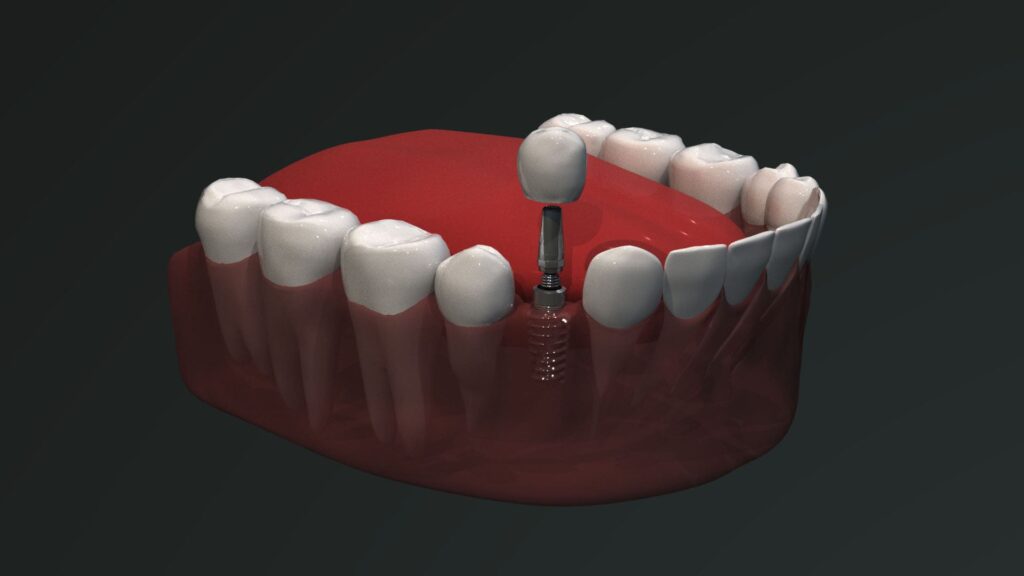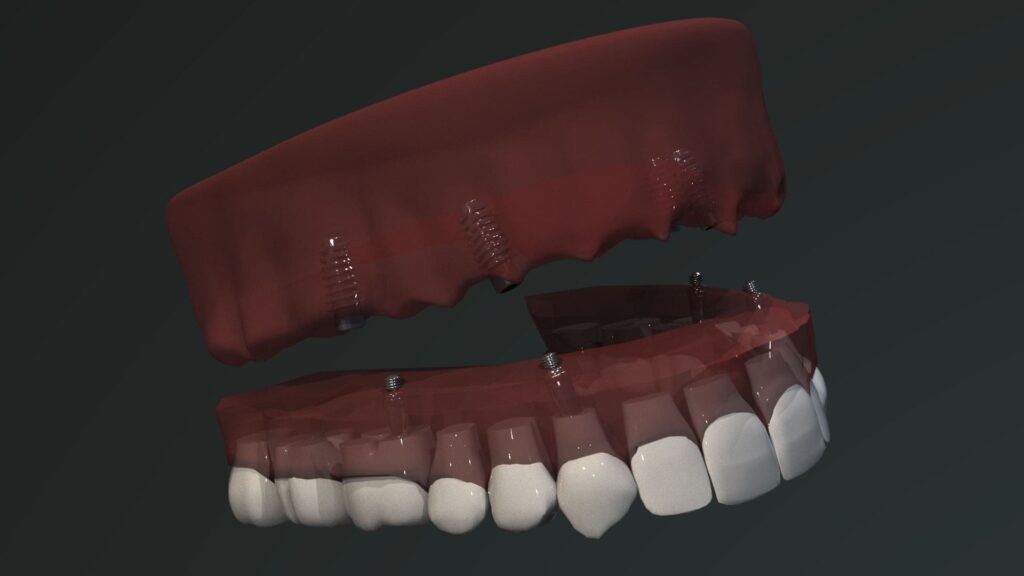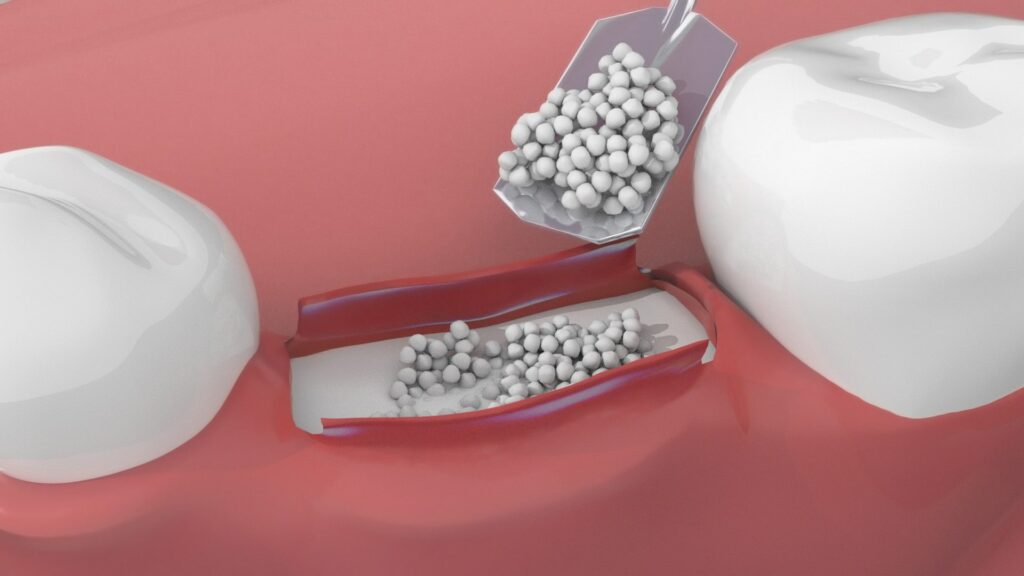
Dental implantation
Dental implantation is one of the most effective methods for regaining good chewing function and a natural, attractive smile. Implants also aid in the prevention of major occlusion faults or crooked tooth issues, as well as the prevention of dental bone loss.
- How is dental implantation performed?
- Types of implants
- Additional procedures required for implantation
- Why are dental implants important?
- How many operations will be required?
- What other procedures are required before dental implantation?
- Dental implants used in our clinic
- Postoperative period
- How to care for dental implants
- Dental implantation in our clinic
- Frequently asked questions
- Pricelist
How is dental implantation performed?
During a dental implantation procedure, a prosthetic root implant is implanted into the bone, where the tooth formerly resided. The implant is a small, hypoallergenic screw made from titanium. After the implant has been installed, a specialised cap is affixed to it, and an artificial crown is placed on top of it. The shape, colour, and functional features of a dental implant crown are nearly identical to those of a natural tooth.
A 3D dental scan is a quick and easy examination that involves scanning a patient’s mouth using a compact scanner tool. When compared to traditional dental impressions, this form of prosthesis modelling is more accurate and convenient. Dental technicians can construct an accurate, high-quality prosthesis using the digital three-dimensional mouth model. Before the treatment, the patient can see a visual model of their future smile.
Dental implantation is performed in either one or two stages:
- Single-stage implantation is performed when the amount of bone in the jaw of the implanted tooth is sufficient to hold the implant firmly. In some cases, bone augmentation may be required during a single-stage implantation. The implant is then immediately installed into the part of the bone already in place. This ensures minimal invasiveness, avoiding the need for multiple surgeries.
- Two-stage implantation is a method used when it is required that we perform bone augmentation in the implantation area. In a two-stage implantation, all the necessary preparatory procedures are performed during the first operation. Preparatory procedures may include sinus lift surgery and bone augmentation. When bone augmentation is performed, the surgical site is sutured and left to heal for 6-12 months (depending on your specific case). Implantation is then performed as normal during the second operation.
Types of implants
Dental implants can be used both when restoring molar and anterior teeth. Modern dental implantation methods allow us to perform minimally invasive operations and ensure the highest possible quality of implantation.
Single tooth implantation

This is the most common type of implantation as it is performed when a patient is only missing one tooth. In this case, a single implant is installed into the bone where the tooth resided, then an artificial dental crown is attached. The prosthetic tooth helps keep other teeth healthy. It stops the process of bone loss and acts as an active support to the adjacent teeth, stopping the formation of the occlusion.
Implantation of several adjacent teeth

When several adjacent teeth are missing, a bridge prosthesis can be affixed. A bridge prosthesis is a construction of several connected dental crowns. Only a few of the crowns get fixed on supports (healthy adjacent teeth or implants). This method of implantation can be performed in cases where it is desired to avoid installing in a large number of implants (e.g. 3 adjacent teeth can be restored on 2 implants) or when it is impossible to install an implant (e.g. a tooth is missing between two healthy ones), they can be used as a support. The main disadvantage of the bridge prosthesis method is that when a healthy tooth is used for the bridge structure, it needs to be shaved to install the crown.
Implantation of the entire dental arch

If a large number of teeth of one or both jaws is missing, an individual prosthesis of the entire dental arch can be made. Depending on the clinical case, 4 to 8 implants are installed into the jaw to secure such a prosthesis. The artificial dental arch is visually very close to natural teeth and significantly restores chewing capabilities.
Additional procedures required for implantation
Sometimes there is not enough dental bone available to perform an implantation. In such cases, additional bone augmentation procedures are performed. Additionally, sinus lift surgery may be performed when dental implants are being prepped for a prosthesis in the upper jaw’s terminal segments and there is a bone defect.
Dental bone augmentation

What is bone augmentation?
Bone augmentation is a procedure performed to increase the volume of dental bone tissue. Bone augmentation may be necessary before implantation when the natural bone is not sufficient for the implant to get firmly fixed to the jaw. Usually, bone augmentation is required if a long time has passed since the initial tooth extraction. This is due to the process of bone atrophy (bone disappearance), caused by the long-lasting absence of biting load. A bone augmentation procedure may also be required after treatment for periodontitis, removal of cysts, or other dental diseases that might have damaged the bone.
How is dental bone augmentation performed?
The operation is performed under anaesthesia. The dental surgeon makes a small incision in the surgical area, exposing the bone cavity. The dental bone is restored with either a special bone augmentation material or a donor bone, from another suitable location in the jaw. The implant is installed immediately if there is enough natural bone to get it fixed. The process of artificial bone adherence then takes place while the implant is already standing.
Sinus lift surgery
What is sinus lift surgery?
Sinus lift surgery must be performed before implantation of the upper lateral molars. Sinuses are the hollow cavities of the facial bones located near the end of the upper jaw. Often, the roots of the upper molars are too close to the sinuses and after their extraction, or if there is damage to the supporting bone(atrophy), it is no longer possible to install the implant into the natural bone. Usually, the teeth growing near sinuses are the last two (sixth and seventh) molars of the upper jaw. Sometimes it can also be the fourth and fifth molars and in rare cases even the canine teeth. In addition, the position of the sinuses is sometimes too low for physiological reasons. In this case, sinus lift surgery is required.
How is sinus lift surgery performed?
During a sinus lift surgery, the upper base of the jaw is lifted and a sufficient volume of bone is restored to allow for the successful placement of dental implants. Sinus lift surgery can be open or closed:
- Open sinus lift surgery is performed by an oral surgeon. An incision is made in the tissues covering the sinus to provide access to its cavity. The mucosa covering the base of the sinus is then brought to a position suitable for implantation. After this, the void formed in the cavity is filled with an artificial bone-like material.
- Closed sinus lift surgery is performed by making an extremely small incision at the site of implantation. A special instrument is inserted through the incision site to lift the base of the sinus. This method of surgery is minimally invasive – there is no swelling after the operation so the healing process takes a significantly shorter time.
In rare cases, especially when a large volume of bone is missing, a sinus lift surgery performed using any of the techniques may fail if the sinus mucosa ruptures. Rupture of the sinus mucosa does not cause serious complications, but the sinus lift operation has to be repeated.
After the sinus lift surgery
After an open sinus lift surgery, swelling and pain may be felt, and a bruise may appear. If the ‘closed’ method of the operation is performed, swelling, bruising or other unpleasant sensations are very rare. After performing a sinus lift, it is recommended to not overheat or overcool, and stop exercising and lifting heavy weights for about a month. It is also important to follow proper oral hygiene and take your prescribed medications (usually a 7-day course of antibiotics). After the operation, the doctor will provide additional, personalised, recommendations which, when followed, aid a rapid healing process.
Why are dental implants important?
People often believe that the lack of one or two teeth will not interfere with chewing and the aesthetics of a smile, so implantation is not necessary. This, however, is false as the lack of even one rearmost tooth can cause serious occlusion problems, disrupting overall health and facial structure over time. There can be many different problems caused by tooth loss:
- Bone loss (atrophy) which can occur at the site of a lost tooth as a result of a lack of chewing force. Atrophy of the lower jaw bone can begin after 6 to 12 months from tooth extraction, and of the upper much sooner (after 2-3 months). Bone loss not only causes negative displacement of adjacent teeth but also complicates the implantation procedure in the future.
- An empty cavity is formed after a tooth is extracted, leaving the adjacent teeth unsupported. Over time, the absence of a tooth can lead to bite defects. It may also cause changes in the features of the face – possible sagging or dropping of the cheeks and chin, wrinkles appearance in the lip areas.
- Loss of teeth and prolonged occlusal defects can lead to chewing impairment and gastrointestinal problems.
- The loss of front teeth can harm your appearance and self-esteem. A person who has lost a front tooth is likely to avoid smiling and have less self-confidence.
- Poor diction due to lack of one or more teeth. Often occurs if the front teeth are lost.
Therefore, it is recommended to plan dental implantation immediately after tooth extraction. This helps to avoid the need for bone augmentation, as well as other negative consequences in the future.
How many operations will be required?
Each patient’s medical case is unique. An experienced dental surgeon always strives to perform dental implantation in a single step, thereby reducing invasiveness. However, one of the most important factors is whether the volume of the natural bone is enough to fix the implant. Sometimes this question can be answered during treatment planning. In other cases, the answer is only to be found during bone augmentation. The dentist may install the implant during the bone augmentation, but only if the available bone is sufficient to hold the implant until the artificial bone filler gets attached. In other cases, bone augmentation and implantation are performed separately.
What other procedures are required before dental implantation?
To ensure successful implant installation and to cure existing dental diseases, the following additional procedures may be required prior to implantation:
- Orthodontic treatment. Occlusal defects need to be fixed with braces or aligners before implantation otherwise the implant could be damaged in the future.
- Professional oral hygiene.
- Dental fillings when there are spots of tooth decay.
- Periodontal treatment of gum diseases (gingivitis, periodontitis).
- Root canal treatment of infected teeth.
- Removal of cysts or other oral growths.
Dental implants used in our clinic
In our clinic, we use reliable Straumann implants which are made of a highly durable, hypoallergenic material: a special titanium/zirconium alloy with one of the highest success rates of up to 98.4%. The unique surface of Straumann implants ensures fusion to the jaw bone, promotes bone formation and has anti-inflammatory properties.
Straumann dental implants are one of the most popular implants used all over the world due to their reliable quality and high success rate allowing dentists to attach dental prosthetics even in the most severe cases of tooth loss.
Postoperative period
- Mild pain and swelling may be felt immediately after the implantation. The dentist may prescribe painkillers for pain relief.
- There will be a small wound left at the site of implantation that may bleed slightly. Sterile gauze swabs are used to stop bleeding by holding them at the surgical site for 30 minutes or until the bleeding stops.
- It is important to not eat for 3-4 hours after the operation. It is not recommended to eat solid, cold or hot food, drink coffee and alcohol or smoke until the implantation site is completely healed.
- It is recommended to hold back from exercising and lifting heavy weights during the first week after implantation.
- The implant site must be regularly and thoroughly cleaned with an ultra-soft toothbrush. Good oral hygiene is one of the most important factors in the postoperative healing process.
How to care for dental implants
There exists a misconception that dental implants require less care than natural teeth. This statement is only partly true. The implant cannot be damaged by caries, pulpitis or other dental diseases. However, the natural tissues surrounding it – the gums and the bone – are not to be forgotten. Poor oral hygiene and the build-up of dental calculus can lead to peri-implantitis, an inflammation of the tissues surrounding the implant. If peri-implantitis is left untreated, the dental implant may be lost. Therefore, it is very important to thoroughly clean the areas around the implant crowns and interdental spaces using a toothbrush and dental floss. It is also recommended that patients carrying implants receive professional oral hygiene more frequently – every 4 months.
Dental implantation in our clinic
In our clinic, we use reliable implants of the highest quality. Our dental prosthetic procedures are performed by specialists with extensive experience in this field. In all areas of dental treatment, the Mackeviciai family dental clinic strives for minimal invasiveness. We believe that quality dental work is where as little natural oral tissues as possible have been damaged or replaced.
By entrusting their dental implantation to us, our patients ensure the lowest possible number of surgical operations, a comfortable treatment process and postoperative period. We always aim to achieve the best functional and visual results possible.
Frequently asked questions
Pricelist
Implantacija
| Implantation using Straumann Roxolid SLActive (Switzerland) | 850 € |
| Implantation using Straumann Roxolid SLA (Switzerland) | 745 € |
| Implantation using Straumann SLActive (Switzerland) | 700 € |
| Implantation using Straumann SLA (Switzerland) | 650 € |
| Implantation using Biohorizons implant (USA) | 550 € |
| Implantation using Medentika implant (Germany) | 545 € |
| Straumann implant healing cap | 80 € |
| Biohorizons implant healing cap | 35 € |
| Medentika implant healing cap | 35 € |
| Soft tissue augmentation during implantation | 250 € |
| Closed sinus lift surgery (with materials) using ultrasound tools | 1000 € |
| Open sinus floor lift surgery (with materials) | 1200 € |
| Bone augmentation after tooth extraction | 100 € |
| Installation of a Bollard orthodontic implant | 360 € |
| Directional bone augmentation | 400 € |
| Large volume directional bone augmentation – €600 | 600 € |











